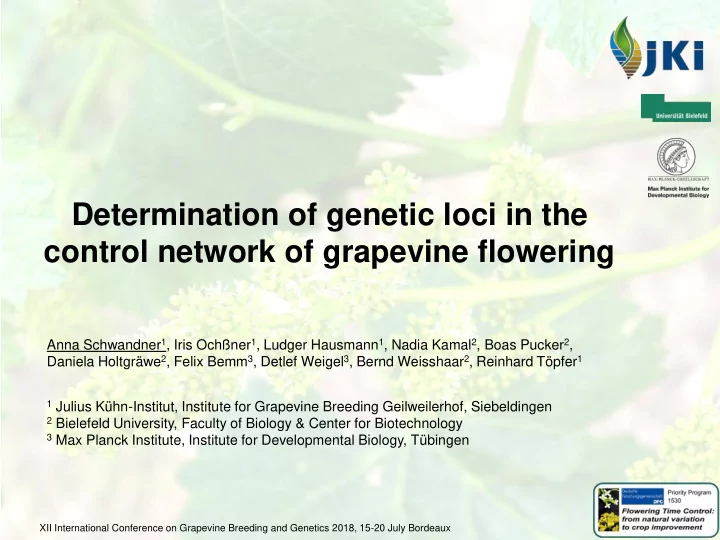

Determination of genetic loci in the control network of grapevine flowering Anna Schwandner 1 , Iris Ochßner 1 , Ludger Hausmann 1 , Nadia Kamal 2 , Boas Pucker 2 , Daniela Holtgräwe 2 , Felix Bemm 3 , Detlef Weigel 3 , Bernd Weisshaar 2 , Reinhard Töpfer 1 1 Julius Kühn-Institut, Institute for Grapevine Breeding Geilweilerhof, Siebeldingen 2 Bielefeld University, Faculty of Biology & Center for Biotechnology 3 Max Planck Institute, Institute for Developmental Biology, Tübingen XII International Conference on Grapevine Breeding and Genetics 2018, 15-20 July Bordeaux
Motivation • Temperature is the main environmental factor affecting grapevine development • Climatic changes and global warming F. Schwander, JKI • Timing of flowering participates in timing of ripening • Knowledge-based breeding of new, adjusted grapevine varieties Anna Schwandner - Determination of genetic loci in the control network of grapevine flowering 1
Aims • Find genetic loci/genes contributing to the timing of grapevine development especially timing of flowering o QTL analysis o Correlation of alleles/haplotypes and flowering time phenotype o Differential gene expression studies over the whole developmental cycle Anna Schwandner - Determination of genetic loci in the control network of grapevine flowering 2
Mapping population GF.GA-47- 42 x ‘Villard Blanc’ ‘ Bacchus’ ‘ Seyval’ ‘ Subereux’ Seibel 6468 early early late late GF.G .GA-47 47-42 42 ‘Villard Blanc’ early ly late ‘ Calardis Musqué ’ 151 F1 individua ividuals ls Anna Schwandner - Determination of genetic loci in the control network of grapevine flowering 3
QTL analysis • QTL on several chromosomes of GF.GA-47- 42 x ‘Villard Blanc’ • Some regions coincide with QTL detected in a second population (Fechter et al. 2014) • Indicates general function of these regions in Vitis flowering • Additive effects of detected QTL observed Anna Schwandner - Determination of genetic loci in the control network of grapevine flowering 4
Additive effects of flowering time QTL • Only one “early” allele (in the QTL on chr. 4 or 14) doesn’t lead to an early phenotype • F1 individuals with both “early” alleles present tend to actually flower earlier • Impact of further QTL possible only "early" allele on chr. 14 only "early" allele on chr. 4 both "early" alleles 50 45 40 Individuals [%] 35 30 25 20 15 10 5 0 1 2 3 4 5 6 very early very late Phenotypic class Anna Schwandner - Determination of genetic loci in the control network of grapevine flowering 5
Main QTL on chr.14 • Consistently recurring QTL in all 10 years • Appears to have the highest impact on time of full bloom • Here only maternal (GF.GA-47-42, early flowering) influence on flowering time Anna Schwandner - Determination of genetic loci in the control network of grapevine flowering 6
Extension of the mapping population • Validation of flowering time QTL on 6 chromosomes in the extended population • QTL on chromosome 14 is again the most prominent • No change in QTL positions „basic population “ „ extended population“ Anna Schwandner - Determination of genetic loci in the control network of grapevine flowering 7
Season spanning RNA-Seq experiments • Four years, two genotypes, buds and inflorescences GF.G .GA-47 47-42 42 • Which genes show differential expression over time and between genotypes? early ly ‘Villard Blanc’ late • Find FTC candidate genes involved in different developmental steps Anna Schwandner - Determination of genetic loci in the control network of grapevine flowering 8
Season spanning RNA-Seq experiments • New FTC candidate genes revealed by their expression patterns • Gene expression patterns of both genotypes support each other in the respective developmental stage • Gene expression relatively stable over the rather long period before dormancy • During and after dormancy genes cluster into two groups: o Genes up-regulated during bud dormancy o Genes up-regulated towards single flower development • Some FTC homologs not expressed in grapevine buds/inflorescences Anna Schwandner - Determination of genetic loci in the control network of grapevine flowering 9
Further approaches • Generation of whole genome sequences of the early and late parent of the mapping population • Creation of a high resolution genetic map based on SNPs derived from RAD-Seq • Association studies with amplicon sequences of selected candidate genes showed a significant correlation with specific flowering time phenotypes • Testing if genetic markers can be applied in MAS Anna Schwandner - Determination of genetic loci in the control network of grapevine flowering 10
Summary • Several QTL for time of full bloom • Proposing putative flowering time and developmental genes on the basis of: o Location within QTL regions o Association of specific alleles with a particular flowering time phenotype o Season-spanning RNA-Seq experiments Anna Schwandner - Determination of genetic loci in the control network of grapevine flowering 11
Thank you for your attention! Acknowledgements Reinhard Töpfer Ludger Hausmann Eva Zyprian Iris Ochßner Andreas Preiß Carina Moock Florian Schwander Daniel Zendler Franco Röckel Robert Richter Florian Rist Nadia Kamal Daniela Holtgräwe Boas Pucker Bernd Weisshaar Willy Keller Prisca Viehöver Felix Bemm Detlef Weigel And the DFG for funding the project. Anna Schwandner - Determination of genetic loci in the control network of grapevine flowering
Recommend
More recommend